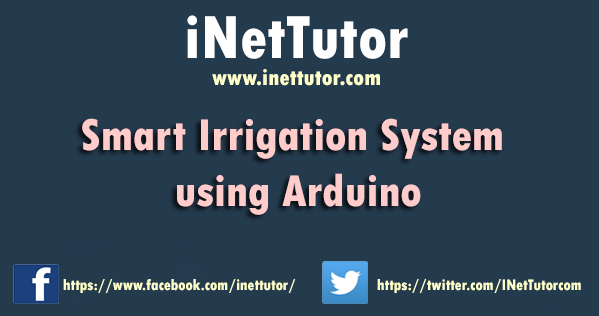Smart Irrigation System using Arduino
The project entitled Smart Irrigation System using Arduino is a hardware-software package wherein users of can control and monitor the irrigation process in their farm using their smartphone.
Related Literature and Studies
This chapter talks about the related literature, relevant studies and synthesis that could help us in developing the proposed system.
Foreign Studies
Ways of Israel that feeds the world
According to Abigael Klein Lehman (2012) stated that probably no other advancement has been quite as significant. While the concept of drip irrigation existed well before Israeli statehood, it was revolutionised by Israeli water engineering. Simcha Blass, who serendipitously discovered that a slow and balanced drip led to remarkable growth. He created tubing that slowly released water where it was most efficient and in 1965 Kibbutz Halperin built a whole new industry. Netafin, based on his invention. Just one recent example of how this method has impacted food supply in different families in Senegal to reap crops three times a year instead of just once even on infertile land.
The researcher learned that the farmer would detect if the soil is dry and the producer will release water from the machine throughout the pipes. Evaporation trimmed down and up to one-fourth of water used is saved, as compared to flood irrigation.
(Retrieved from http://www.esrael21c.org/the-top-12-ways-Israel-feeds-the-world/)

Border Irrigation System
According to James G. Thomas (2014) stated that border irrigation is an old irrigation system used in the western part of a fresh, high bed or row. The depth of water flow is shallow and uniform down the bordered area. It is a system where a large volume of water was deposit in a defined edge or bay at the top of the field. Unlike rice/soybean rotations, flooding was used as an irrigation system for soybeans, the borders have a shallow, uniform water flow and can be used to irrigate soybeans or other crops when they are small; you do not have a danger submerge. Run the water until it reaches the end of the field or closer to the end so the entire border is watered out. The soil types of many of the field’s area often a cracking clay that helps distribute water. The cracks give a random distribution of the water and help disrupt the potential for channelling through the border.
(http://msurcares.com/pubs/publication/p2038.html#/)
Sustainable Management of Tank Irrigation Systems in India K.Palanisami
According to K. Palanisami (2011) stated that an irrigation tank is a small reservoir constructed across the slope of a valley to catch and store water during rainy season and use it for irrigation during the dry season. Tank irrigation systems also act as an alternative to pump projects, where energy availability, energy cost or ground-water supplies are constraints for pumping. The distribution of farmers receives inadequate of water from tanks. This system has a special significance to the limited and small-scale farmers who make an enormous number primarily depending on tank irrigation as these systems are less capital-intensive and have wider geographical distribution than large projects, it maintains levels of groundwater, and it is a cheap and traditional method of irrigation.
(Retrieved from: sa=t&rct=j&q=&esrc=s&source=web&cd=1&cad =rja%vad=8&ved=0ahUKFwjl6a36NXKAhuCrKYKHbOeAGIQFggaMAA&url=http%3A%2F%2www.nourtn.tsukuba.ac.jp%2F2tasae)
Local Studies
Wind Pump Irrigation System- agris
According to Prof. Belonio year (2011), stated the wind pump irrigation system is suitable either for individual, group of farmers, large corporate farms, or even government experiment stations. He said that the wind pump irrigation system is environment friendly. No manual operation during stormy periods and there is no risk of losing the machine even if it is installed and left in the field.
The researcher learned that the Farmers will benefit from using wind pump for irrigation purposes. It eliminates the use of imported fossil fuel which is generally expensive. Also, it ensures a year-round supply of, water especially during windy periods.
(Reference:agris.fao.org/agris/search./do?recordID= PH2000101260)
Water Supply for Rural Areas and Small Communities
According to Sebastian year (2015) stated that the water supply is the process of providing water in a systematic early through installed pumps and pipelines. Before water is provided to a specific area it undergoes approximately sanitation to ensure that the quality of water received is made for human consumption. The Philippines water supply system dates back to 1946 after the country achieved to independence government agencies.
(Reference: www.who.int/water sanitation health/dwg/ monograph42.pdf)
PRIOR ART
Automated Irrigation System using thermoelectric generator as Soil Moisture Detector
According to the Researcher of DLSU (2013) stated that manual irrigation system do not promote water conservation that result to too much water or to small amount of water in the soil thus poor plant growth. Automated irrigation systems are capable of determining and maintaining the right amount water for the soil. Two TEG’S were used as the soil moisture sensors (one as the control and the other in the plant area) that produced voltage differentials proportional to the relative wetness or dryness of the compared to control the uses of thermoelectric generator as the soil moisture sensor that uses the temperature difference between the air and the soil as a basis for irrigation.
The researcher learned that the thermoelectric generator as a soil moisture requires relatively constant heat source and have slow technology progression and have limited applications. But irrigates according to the proper needs of the soil, thus, saving water consumption and improving water efficiency and use.
(Reference:www.dlsu.edu.ph/conference/dlsuresearch congress/2013 pdf/SEE/SEE-V 144.pdf)
Synthesis
The Smart Irrigation System using Arduino helps to lessen the work needed to be done by the farmer and it give benefits to the owner of the farm. The said system can reduce water consumption and there is no need to use the manual operation even during stormy periods because the system will be the one who manage automatically to irrigate the entire farm. The Smart Irrigation System is a low cost project that even poor farmers can afford because it is only consist of simple circuitry and sensor.
The different studies stated above shows that the Smart Irrigation System can help the farmers to make their work easier. By this, it gives the researcher the go signal to make the system.
Credits to the authors/developers
You may visit our Facebook page for more information, inquiries, and comments. Please subscribe also to our YouTube Channel to receive free capstone projects resources and computer programming tutorials.
Hire our team to do the project.


